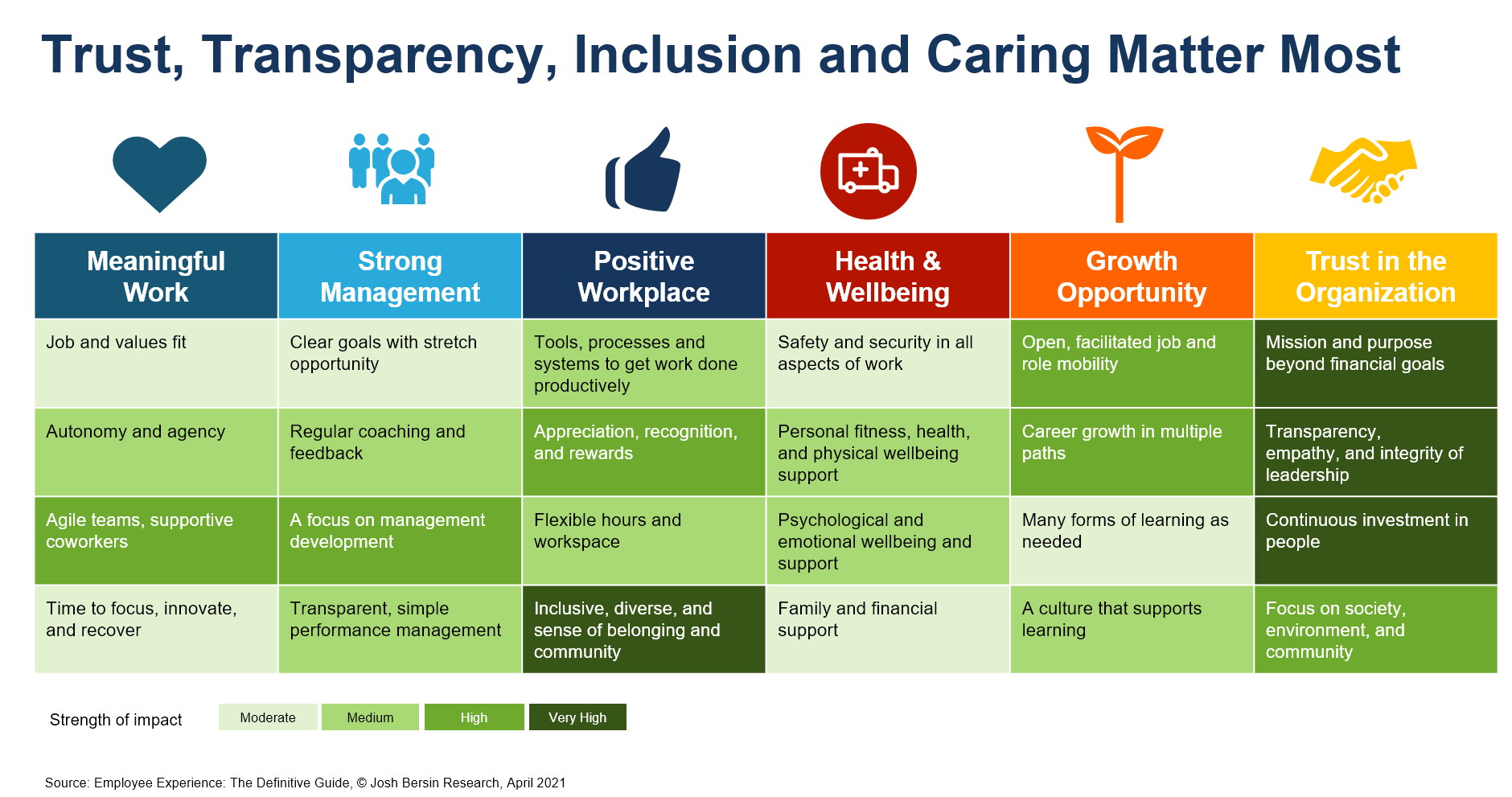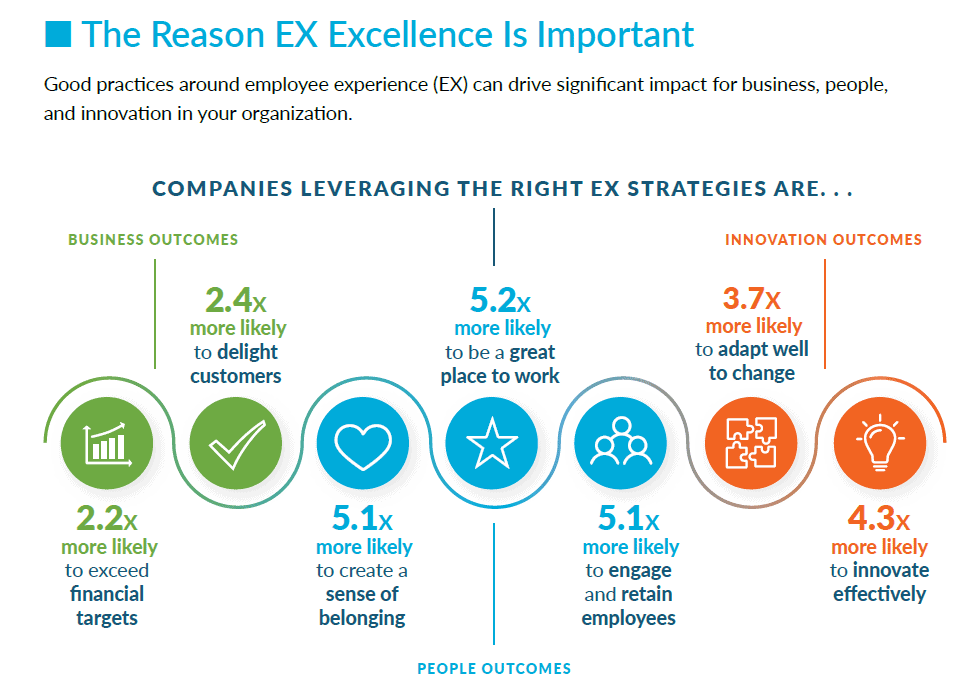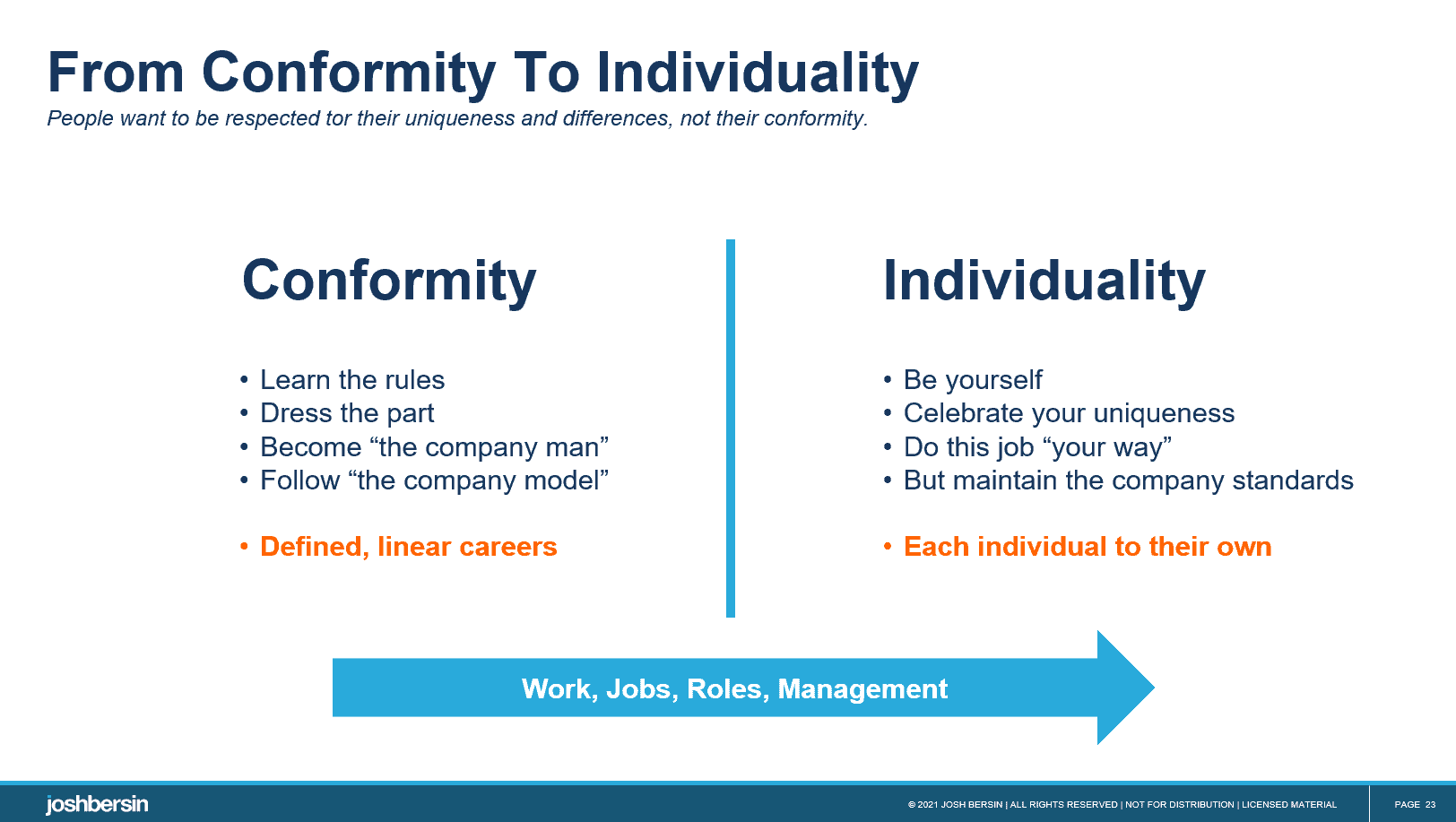Secrets To Employee Experience: The Definitive Guide Launches Today
This week we’re launching one of the most important research studies we’ve done: a comprehensive look at Employee Experience. We call it the Employee Experience: The Definitive Guide, and you can download the report here and the detailed infographic here.
About The Study
Our EX study was launched in January of this year. The study collected input from 982 companies on 90 practices related to Employee Experience, including job design, management, workplace design, health and well-being, growth opportunities, technology, and services.
The Research Goals:
The goals of the study were as follows:
- To create a clear definition of the term “employee experience.” Currently, no such standard exists; the term has different meanings to different audiences.
- To quantify, using research and case studies, why EX is important for HR organizations and business leaders.
- To identify the practices that have the most significant impact on employee experience.
- To offer specific guidance on how organizations can improve employee experiences and achieve EX excellence.
Top Findings:
Of the 90 practices analyzed, 15 were found to have the greatest impact when related to financial, people, and innovation outcomes.
- Practices related to trust, transparency, inclusion, and caring have a disproportionate impact. Important practices include regular and transparent communications from leaders, demonstrations of care for employees, an emphasis on integrity and empathy across an organization, a well-defined company mission, and a culture that cultivates a sense of belonging and inclusion among all employees.
- The study identified four levels of EX maturity: Level 1, Transactional Efficiency; Level 2, Supportive Environment; Level 3, Purpose-Driven Business; and Level 4: Equitable Growth. Only 20% of companies represented in the survey are at Level 4.
- The use of technology is critical to creating and sustaining positive employee experiences. Without the right technology, companies can’t get insights into employee sentiment, provide personalized and job-relevant experiences and development opportunities, or support employees at scale. This study found that the use of certain types of technology correlated to different maturity levels for employee experience.
 |
Why Is Culture So Important?
As you can see from the findings, the most important practices revolve around culture. Why is culture is so important?
First, we are in the middle of one of the most competitive job markets in decades. In April more than 4 million Americans voluntarily quit their jobs, showing their level of dissatisfaction and market power. So employees are looking around. And as they look, they’re searching for empathetic, caring, and responsible employers.
Stress is one big issue. Today, according to Deloitte’s latest Millennial Survey (21,000 respondents in 46 countries), over 46% of younger workers now say they feel stressed “all the time,” and almost half state that their employer “did nothing” to help them.
What are people stressed about? Many things. Four in ten believe global climate change has hit “the point of no return.” Two-thirds believe wealth is unfairly distributed and the cause is “greed and self-interest by business/wealthy people.” And six in ten think systemic racism is widespread.
And the issue of belonging looms large. Nearly a quarter of workers feel their employer has personally discriminated against them. And one in five feel personally discriminated against “all the time” because of some aspect of their background.
So before we simply raise wages or add perks to make employees happy, we have to focus on the core.
- Employees want a feeling of purpose from their employer.
- They want to trust their leaders and institutions.
- They want to feel that they belong and that their team will take care of them.
- They want to be treated fairly, respecting their uniqueness and identity as a person.
- And they want to see the company investing in their pay, growth, and advancement.
Where Are Companies Today?
While many companies perform well among these factors, it’s still the minority. When we clustered the respondents into groups, we found that only about one in five achieves what we call EX Excellence. Far too many think EX is a program to make Human Resources efficient: this is really only the beginning of the journey.
 |
And yes, technology does matter. The study identified several very important technology investments: tools for employee listening, analytics tools to identify problems, and AI tools that provide suggestions for wellbeing and improved productivity.
The ROI Of Employee Experience
Since the topic of EX grew out of employee engagement, companies are not always clear about the return on investment. Well it’s now very clear that when employee satisfaction is high, customer satisfaction and financial growth follow. As I often tell clients in our conversations, your employees “are” your company, so the more productive and engaged they are, the faster you company will grow.
Our research clearly proved this out.
 |
A Few Lessons Learned
First, EX is not purely a technology initiative.
Companies often think the EX strategy is a tech strategy. Yes, technology is important (our study found that listening systems are very important), but culture comes first. And creating collaboration systems does not create a collaborative culture. The opposite is true: whatever tech you buy, it will reinforce the culture you already have.
Think about every job you’ve ever had. At times the tech got in the way, but even when these problems were fixed it was the management, teamwork and work itself that matters.
Second, focus leaders on respect, inclusion, and belonging.
The Deloitte research points to something I’ve observed over the last few years: today every employee wants to feel unique. And this focus on uniqueness means we have to create a sense of inclusion, belonging, and respect.
Did you know, for example, that there are more than 40 definitions of “gender” in modern HR systems? This points to the fact that people thrive on their individuality and differences from others, and all they ask is for your company to respect and understand these differences.
 |
I recently posted a podcast on my ten principles of leadership, and I discuss how important it is to listen, respect people’s differences, and take time to let people speak up. These topics are central to EX, so make sure they’re part of your program.
Third, invest in programs to help people grow.
Many of our studies have shown that when people leave organizations, the #1 driver is “lack of progress.” And in this economy, everyone has to grow and learn all the time. So give people opportunities to learn, ask others for help, and try new assignments. These growth, development, and mobility options are tremendously important issues. Companies like Bank of America saw their retention rates skyrocket when they put regular development and growth into their retail business.
Fourth, double down on company mission and purpose.
It’s interesting to me that so many younger workers want business leaders to be more ethical. The Millennial Survey found that almost 70% of workers believe “business leaders are greedy and self-centered” and this is what holds society back. (I have to say, watching three billionaires compete to fly into space when we have such tremendous problems in homelessness, income inequality, and climate does make me wonder.)
This means you, as a manager or business leader, have to continuously remind your team “why we are here.”
I’ve talked with hundreds of companies about this issue and the simple story is this: companies make money because of what they do; they don’t make money as a goal. Financial performance is an outcome of solving individual or society’s problems, inventing new products and services, and continuously improving lives for people. If you don’t think about your company that way, you’re missing a huge opportunity.
Fifth, make technology easy and focus on employee listening.
As I talk about in the podcast, technology is a big part of EX. While it’s not as important as many cultural issues, it can make a huge difference. The report shows you how to architect EX and what different tools do, but the big message is that we want to make technology “go away.” People shouldn’t feel overwhelmed by tools: they should be easy to pick up and use.
Among all the tech we looked at, the areas that had the biggest impact on results are listening and analytics. Every company has a variety of survey and analysis tools, a great EX program includes a program and integrated platform for listening, feedback, and response Read our article on “Shortening the Distance from Signal to Action” to learn more about this area. We call this the “continuous response” to EX, which builds on what companies do for customers.
Sixth, make wellbeing a part of your entire business strategy.
This research also reinforces the simple idea that people cannot succeed at work if they aren’t thriving in their life. Management disciplines like appreciation (saying thank you to people), flexibility (letting people work where and how they prefer), focus (not asking people to do too many things at once), and space (letting people take time off), are essential to EX.
Work can be exciting, rewarding, and great for your ego. But if people do not feel healthy and energetic, the business will suffer.
EX Is A Business Imperative, Not An HR Program
Let me close with one more point: EX is not just an employee strategy. Companies with great employee experience simply outperform in every way. When you take care of your employees, they take care of your company.
Employee Experience: The Definitive Guide (Research Report)
Employee Experience: The Definitive Guide (Infographic)
The Voice of The Employee – New Course In The Josh Bersin Academy
The Crusade For Employee Experience: How Did We Get Here?
Employee Experience 4.0: Shortening The Distance From Signal To Action

